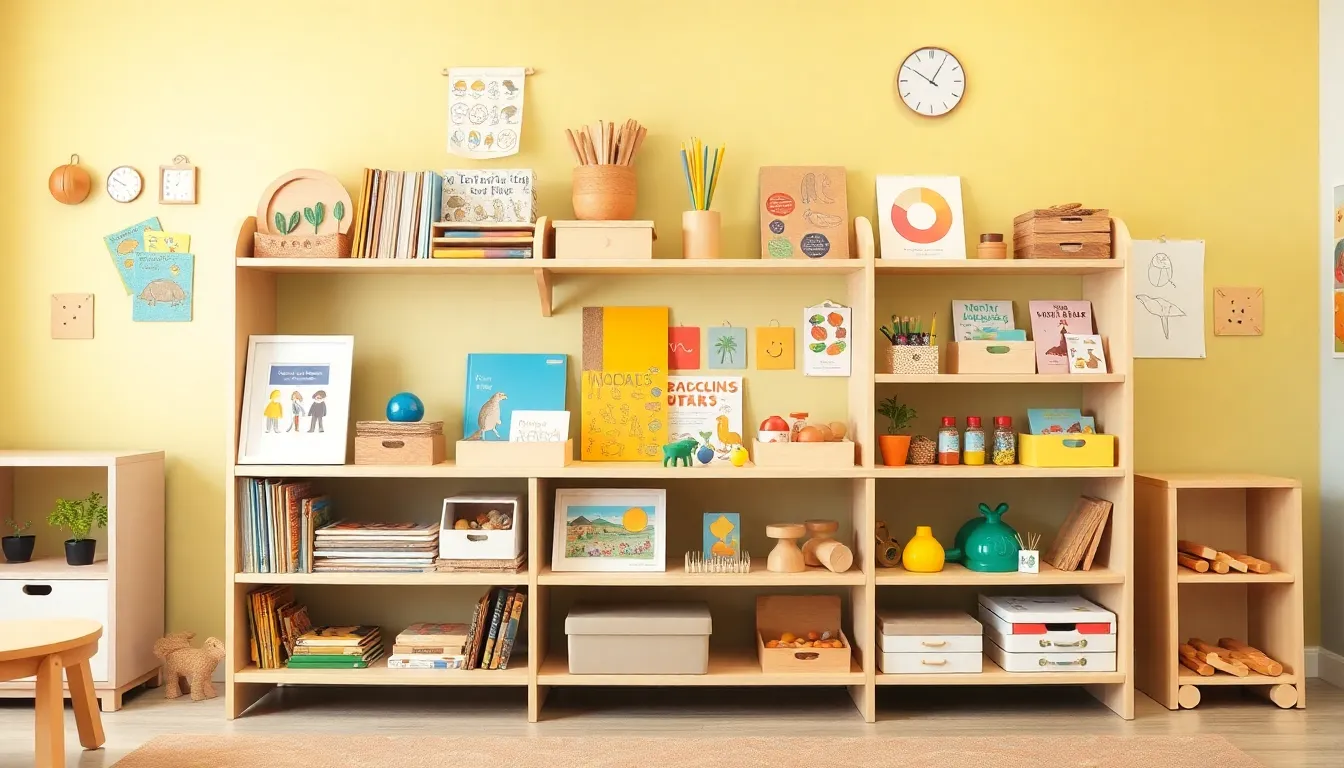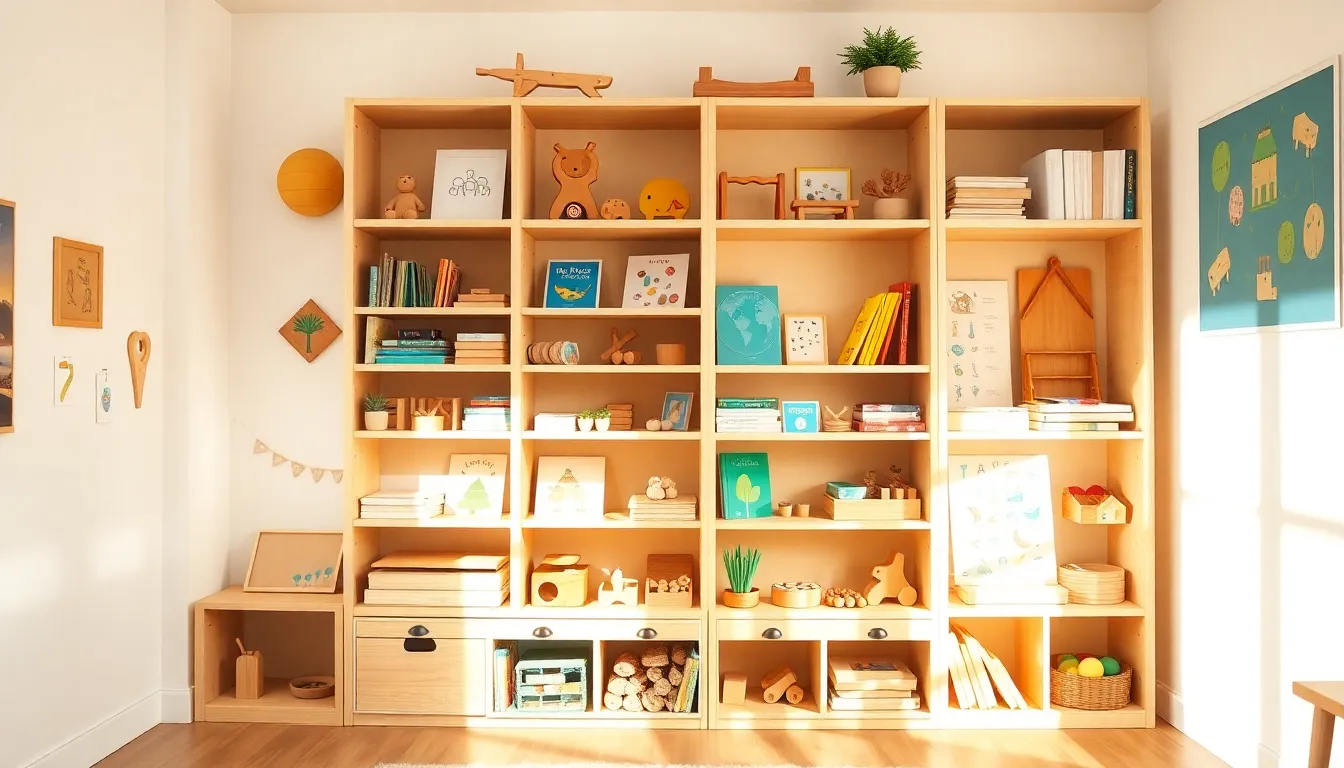Table of Contents
ToggleIn the world of Montessori education, the humble shelf is a secret weapon for fostering independence and creativity in children. Think of it as the ultimate playground for little minds, where every item has a purpose and a story. If you’re tired of toys scattered like confetti and want to transform your space into a haven of organized chaos, you’re in the right place.
Overview of Montessori Shelf Ideas
Montessori shelf ideas focus on creating an engaging, inviting space tailored to children’s developmental needs. Organized shelves serve as a vital component in a Montessori environment, ensuring children can access materials independently. Displaying items at child-eye level encourages self-directed learning and exploration.
Thoughtfully arranged shelves promote order and simplicity. Using clear storage containers allows children to see what’s available, supporting their ability to choose activities based on interest. Incorporating varied materials—like books, puzzles, and art supplies—stimulates creativity and critical thinking skills.
Selecting natural materials for shelves fosters a connection with the environment. Using wood, fabric, and metal can enhance tactile experiences while remaining aesthetically pleasing. Rotating shelf items regularly maintains interest and encourages children to engage with different learning opportunities.
Incorporating specific themes helps focus learning. Seasonal displays or concepts like nature or colors can guide children’s exploration. Designating sections for practical life activities empowers children to cultivate essential life skills, such as pouring or cleaning.
Utilizing vertical space maximizes efficiency. Stacking or utilizing multi-tiered shelves allows for more materials without overwhelming the area. Each shelf can be dedicated to a different subject area, maintaining clear organization and facilitating focused exploration.
Maintaining a clutter-free environment remains essential for effective learning. Regularly assessing the shelf setup prevents overcrowding and keeps materials relevant. Establishing consistent routines for children helps them understand the importance of shelf organization and care.
Montessori shelf ideas play a crucial role in fostering independence, creativity, and active learning in children. By focusing on accessibility, organization, and thematic experiences, these carefully curated shelves create an ideal learning environment.
Key Principles of Montessori Shelves

Montessori shelves revolve around intentional design that supports children’s learning and development. These principles guide the effective use of shelves in educational settings.
Child-Centered Organization
Child-centered organization prioritizes the needs and interests of children. Each shelf should reflect their developmental stage, showcasing materials that stimulate curiosity. Shelves should arrange items logically, creating a visual flow that aligns with children’s exploration. By categorizing resources—such as art supplies, books, and sensory materials—children can engage with specific themes or skills. The display of materials at child-eye level invites children to choose independently. Using clear storage solutions further enhances visibility, allowing kids to locate items easily.
Accessibility and Independence
Accessibility and independence foster children’s self-directed learning. Shelves must contain materials within reach, enabling children to explore without adult assistance. Careful selection of items ensures they are safe and engaging. Every item on the shelf should encourage discovery, promoting decision-making and responsibility in children. Rotating materials regularly keeps the shelf fresh, maintaining interest and motivation. Establishing a routine for returning items also reinforces self-discipline and care. Through these practices, children gain confidence while actively participating in their learning environment.
Choosing the Right Materials
Selecting appropriate materials is essential for a Montessori shelf. It promotes engagement and supports children’s developmental needs.
Natural and Open-Ended Materials
Open-ended materials stimulate creativity and exploration. Items like wooden blocks, fabric scraps, and natural objects encourage imaginative play. Tactile experiences enhance learning, making natural materials ideal for this purpose. They promote sensory development while maintaining visual appeal. Sustainability also becomes a factor, as these materials often have minimal environmental impact. Choosing versatile items allows for varied uses, fostering limitless creative opportunities.
Size and Scale Considerations
Size and scale significantly influence the effectiveness of shelf organization. Materials should be easily accessible to children, positioned at their eye level. Assuring that items are neither too large nor too small enhances independence in selecting activities. Oversized toys may limit accessibility, while tiny components can create frustration. Consideration of weight impacts ease of use; lightweight materials allow for safe handling. Shelves should accommodate children’s movements and spaces, ensuring comfortable exploration and engagement. Prioritizing these factors contributes to an inviting and functional educational environment.
Creative Montessori Shelf Ideas
Montessori shelves can be both functional and inviting. Thoughtful organization and creative themes enhance the learning experience.
Themed Shelves for Different Subjects
Thematic shelves encourage exploration of specific subjects. Math materials can include counting beads, number puzzles, and shape sorters. Language shelves might contain letter tiles, books, and storytelling props. Science themes can support hands-on experiments, with items like magnifying glasses or plant life cycles displayed. Each theme should reflect children’s interests, promoting curiosity and engagement. Clear labeling helps children navigate the materials independently. Colorful arrangements create visual appeal, inviting children to interact with their learning.
Incorporating Seasonal Changes
Adapting shelves to reflect seasonal changes keeps the environment dynamic. Displaying items related to holidays, weather, or nature allows children to connect with their surroundings. For spring, include gardening tools and flower arrangements. In autumn, showcase pumpkins and leaf crafts. New materials can stimulate interest and spark discussions. Rotating items regularly sustains engagement and reinforces the concept of time. Seasonal decorations can also inspire creative projects and hands-on activities, encouraging children to explore themes in-depth. Focusing on this adaptability fosters a sense of community and awareness of the changing world.
Tips for Designing Your Montessori Shelf
Designing a Montessori shelf involves careful consideration of layout, aesthetics, safety, and maintenance. Parents and educators can create an inviting space that encourages independence, exploration, and creativity.
Layout and Aesthetics
Effective layout promotes accessibility and functionality. Arrange materials at a child’s eye level to foster independence. Using clear containers allows children to see what’s available, making it easier for them to choose activities. Consider incorporating natural materials like wood or fabric for a warm, inviting atmosphere that enhances sensory experiences. Balance functionality with visual appeal, creating a cohesive look that aligns with children’s interests. Regularly changing shelf themes keeps the environment dynamic, maintaining engagement and curiosity throughout the learning journey.
Safety and Maintenance
Safety should always be a priority. Secure shelves to walls to prevent tipping, ensuring stability. Opt for non-toxic materials to protect children’s health, especially for items frequently handled. Regular maintenance includes checking for wear and tear on materials, replacing items as necessary to maintain engagement. Routine organization helps children learn responsibility and respect for their environment. Encouraging children to participate in maintaining their space fosters accountability and reinforces the importance of caring for learning materials.
Implementing Montessori shelf ideas can significantly enhance a child’s learning environment. By prioritizing accessibility and organization, these shelves empower children to explore and learn independently. The thoughtful arrangement of materials not only fosters creativity but also instills a sense of responsibility and care for their space.
Incorporating natural and open-ended materials adds depth to the learning experience, while thematic displays keep the environment dynamic and engaging. Regularly rotating items ensures sustained interest and encourages children to take ownership of their learning journey.
Ultimately, creating a well-designed Montessori shelf is a step towards nurturing independent thinkers and active learners, making it a vital component of any Montessori setting.





